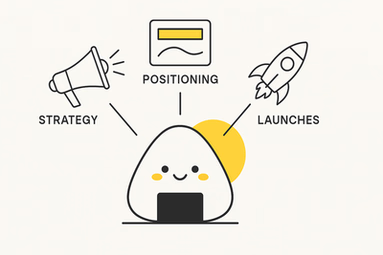.png)
Product Marketing Management: Positioning & GTM Launches
Learn product marketing management: craft positioning, build go-to-market strategy, and run launches with checklists & frameworks. Start here.

How Product Marketing Drives Product Success: Strategy, Positioning & Launches
Product marketing management (PMM) is the connective tissue between your product, market, and revenue. Done well, PMM translates customer insight into sharp product positioning, orchestrates a repeatable go-to-market strategy, and fuels adoption with launch campaigns and enablement. This guide breaks down the PMM fundamentals, from research and messaging to a pragmatic product launch checklist you can reuse.
What Is Product Marketing Management?
Product marketing management owns the story of the product in the market. It’s part strategist, part storyteller, and part orchestrator. PMM connects market intelligence (who we serve, why they buy) to the choices that drive growth (what we build, how we price, how we launch, how we enable).
Core outcomes:
- Clear positioning and differentiated messaging
- Documented go-to-market strategy aligned to revenue targets
- Effective launches that accelerate adoption and expansion
- Enablement that equips sales, success, and partners to win
- A feedback loop that shapes roadmap and pricing/packaging
Product Marketing vs Product Management
People often ask about product marketing vs product management. Here’s the clean split:
- Product Management (PM): Owns what to build and why from a customer problem/solution lens; prioritizes the roadmap; defines success criteria. If you want to know more, we have the perfect article.
- Product Marketing Management (PMM): Owns who it’s for, why it’s different, and how it wins in market; drives positioning, pricing & packaging inputs, launches, and sales/CS enablement.
Great orgs pair them: PM discovers, PMM validates and tells the story, and together they de-risk go-to-market. They are an amazing team, and that's when Product Leadership comes in.
The PMM Operating System
1) Research
- ICP (ideal customer profile): industry, firmographic band, tech stack, pains, triggers.
- Personas: economic buyer, technical buyer, daily user; objectives, objections, decision criteria.
- Competitive & category: alternatives, table-stakes vs differentiators, category tailwinds.
- Voice of customer: interviews, win/loss, support insights, community threads.
Deliverables: ICP brief, persona cards, competitive snapshots, win/loss summary.
2) Strategy
- Positioning & messaging framework anchored in value, not features.
- Pricing & packaging inputs: value metrics, good-better-best hypotheses.
- GTM plan: target segments, motion (PLG, sales-led, or hybrid), channels, enablement plan, KPIs.
Deliverables: Positioning doc, narrative (“why now”), GTM one-pager, success metrics.
3) Execution
- Launch management: tiering, milestones, owned/earned/paid plan, content calendar.
- Enablement: pitch, demo, objection handling, competitive talk tracks, FAQs.
- Measurement: adoption curve, funnel diagnostics, qualitative readouts.
Deliverables: Launch brief, integrated calendar, enablement kit, dashboard.
Positioning That Sticks: A Simple Messaging Framework
Your messaging framework is the single source of truth for how the product speaks.
Template (fill in the blanks):
- For [ICP/segment]
- Who [job-to-be-done / core pain]
- Our product [category]
- Delivers [key value/outcome]
- Unlike [primary alternatives]
- We [credible differentiator/proof]
Example (B2B analytics):
For modern RevOps teams who struggle to unify pipeline data, SignalBoard is a revenue analytics workspace that delivers trustworthy forecasts and deal insights in minutes. Unlike spreadsheet-heavy BI tools, SignalBoard ships with native CRM connectors and prebuilt playbooks so teams act on signals, not spreadsheets.
Messaging layers:
- Core narrative (“why now”): the macro shift creating urgency.
- Value pillars (3–4) with proof points, customer quotes, and micro-proof (benchmarks, integrations).
- Feature→Benefit mapping: every feature connects to a business outcome.
- Objection handling: price, migration, security, “we built this in-house.”
How to write a positioning statement that converts:
- Start with the customer moment (trigger/event).
- State the cost of the status quo.
- Name the new approach (your product).
- Provide specific proof (case, metric, integration).
- End with a clear next step.
Your Go-to-Market Strategy
A go-to-market strategy aligns audience, motion, and channels with revenue goals.
1) Segmentation & ICP
- Prioritize 1–2 beachhead segments; define exclusion criteria to stay focused.
- Map triggers (new leadership, tool migration, compliance change) to outreach plays.
2) Motion
- PLG: Free tier, self-serve onboarding, in-product prompts, PQLs to sales.
- Sales-led: Problem discovery, ROI narrative, tailored demos, multi-threading.
- Hybrid: Product-led acquisition with sales for expansion/enterprise.
3) Channels & Content
- Owned: website, docs, webinars, community, email.
- Earned: analyst notes, podcasts, guest posts, founder AMAs.
- Paid: search for bottom-funnel, targeted social for narratives.
4) Offers
- Trials, pilots, migrations, premium integrations, bundles.
- Use pricing/packaging to steer “good-fit” customers into the right plan.
5) Measurement
- Top: traffic quality, demo/self-serve signups, PQL/MQL conversion.
- Mid: stage velocity, win rate by segment, competitive rate.
- Post: activation, adoption (WAUs/DAUs by persona), expansion, churn reasons.
We love this guide about finding product market fit in B2B on Lenny's Newsletter.
Product Launch Checklist
Not every release is a “major launch.” Tiering keeps you sane and focused.
Tiering
- Lite: bug fixes, UI polish, smaller improvements.
- Standard: net-new features, integrations, plan changes.
- Major: new product, pricing/packaging change, category narrative.
Universal Checklist (adapt per tier)
- Brief & goals: audience, problem, outcomes, KPIs, tier.
- Readiness: docs updated, support macros, status page, analytics events.
- Messaging assets: one-liner, value pillars, before/after graphics.
- Web & content: landing page/module, blog, email drips, release notes.
- Sales/CS enablement: pitch deck slide(s), demo script, battlecard, FAQs.
- Campaign plan: owned (email, in-product), earned (PR/podcasts), paid (retargeting/search).
- Internal launch: company-wide enablement call; who to ping and when.
- Customer proof: beta quotes, case snippet, social proof.
- Legal & compliance: privacy/SOC2 claims, trademarks, usage guidelines.
- Post-launch: dashboard, daily readouts, backlog for feedback, follow-up content.
Pro tip: For a major launch, build a “day 0 / day 7 / day 30” content arc: announce, deepen with case studies, then publish ROI proof or a teardown webinar.
Enablement
Strategy dies without enablement. PMM should make winning the default.
Core assets:
- Pitch & deck: problem framing, outcomes, proof.
- Demo narrative: story-first, then features; tailored to persona.
- Objection library: security, price, migration, build-vs-buy.
- Competitive battlecards: trap-setting questions, flanks, proof.
- Playbooks: SDR sequences mapped to triggers; CS expansion plays.
- Release notes that sell: “what’s new” → “what you can do now.”
Host this in a single source of truth (e.g., a Notion hub or CMS) and keep it versioned.
Metrics That Matter
PMM metrics should ladder to pipeline and revenue, not likes.
- Positioning resonance: win/loss reasons, competitive win rate lift.
- Launch performance: feature adoption, activation, time-to-value.
- Pipeline: PQL→SAL conversion, influenced pipeline, segment coverage.
- Enablement impact: talk-track usage, deal velocity, objection close rate.
- Retention/expansion: feature stickiness, seat expansion, churn reasons tied to value gaps.
Create a lightweight dashboard with weekly readouts and a monthly narrative (“what we believed, what happened, what we’ll change”).
Common Pitfalls
- Feature-first messaging: customers buy outcomes, not menus.
- Over-tiering launches: everything can’t be Tier 1; protect attention.
- Vanity metrics: focus on qualified signals and revenue-adjacent metrics.
- One-and-done enablement: treat enablement like product—iterate.
- No feedback loop: bake win/loss and CS insights into roadmap and pricing.
Conclusion
When product marketing management runs on insight, not instinct, it becomes your growth engine. Ground your positioning in real customer pains, align your go-to-market strategy to a focused ICP, and execute launches with clear tiering and enablement. If you do those three things consistently, you’ll raise win rates, speed adoption, and ship fewer features that miss the mark.
FAQ
Positioning, messaging, launch strategy, enablement, win/loss, and market insights. PMM also influences pricing & packaging and partners with PM on roadmap bets.
PM defines what to build and why; PMM defines who it’s for, why it’s different, and how it wins in market—then proves it with adoption and revenue impact.
Yes. A framework ensures every channel tells the same story. It’s your source of truth for value pillars, proof points, and objection handling.
A brief with goals/tier, readiness, messaging assets, content plan, enablement, campaign calendar, legal checks, and a post-launch measurement plan.
Run five customer interviews + five win/loss calls, rewrite your one-liner and proof points, test two variants on a landing page or email sequence, then iterate.
Read More Posts
.png)
Stakeholder Management Best Practices for Product Teams
.png)
Mastering Product Success: Designing for Seamless Adoption
.png)
Pricing Strategy Explained: The 4 Types & When to Use Each
.png)
The Power of Cost-Benefit Analysis for Product Teams
.png)
Navigating Client Requests: Opportunities in B2B
.png)


